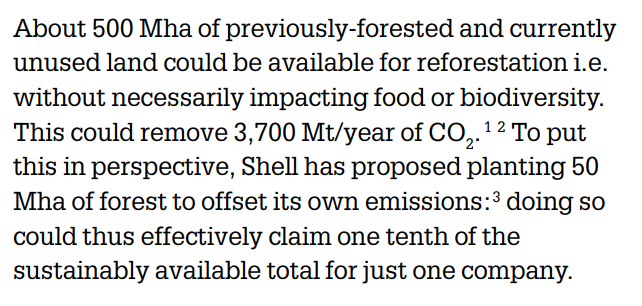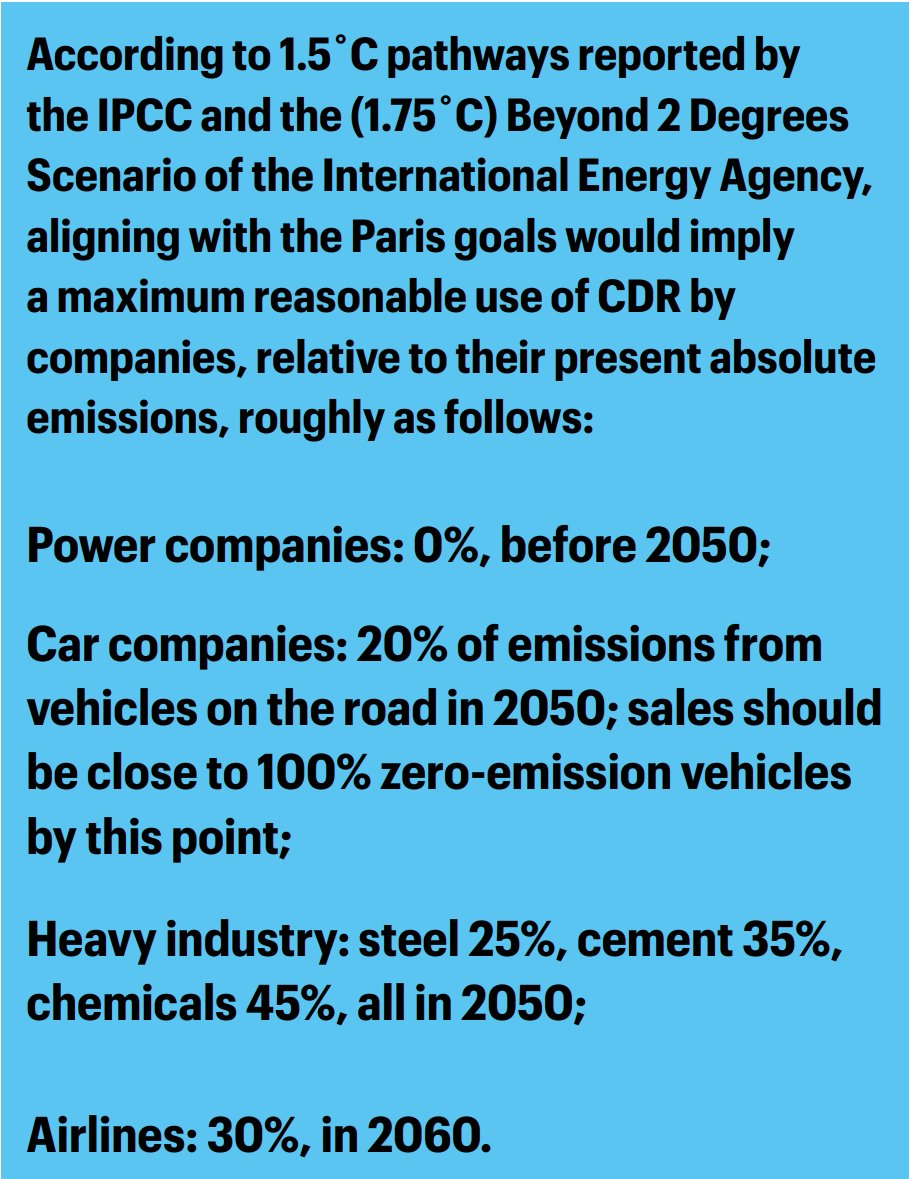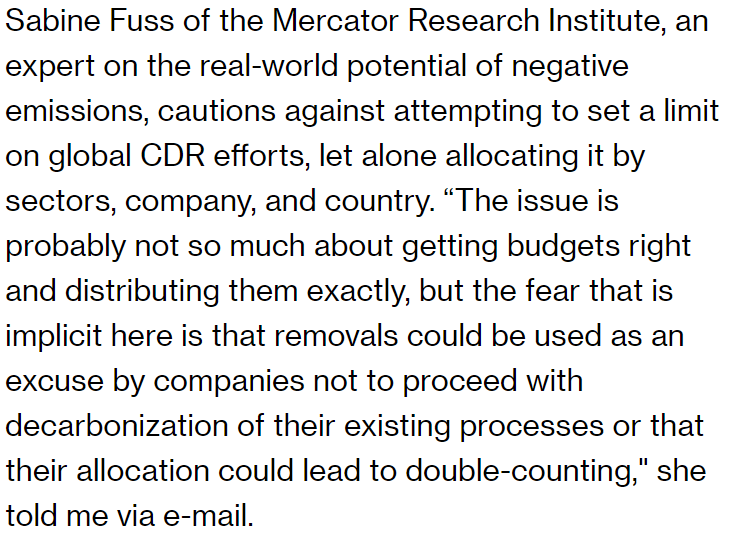Thread about my latest for @climate newsletter, which explores how some companies are beginning to rely on aggressive use of "negative emissions" in their declarations of "net zero targets": https://www.bloomberg.com/news/articles/2021-01-15/too-many-companies-are-banking-on-carbon-capture-to-reach-net-zero?sref=63ZrW3mM
Negative emissions have been a very controversial topic in the world of defining climate action. They're also a confusing topic! Carbon dioxide removal (CDR) includes planting trees, but also includes highly-engineered, energy-intensive, expensive "direct air capture". And more.
These days lots of countries & companies are saying they'll achieve net zero emissions by 2050 (or thereabouts). That's broadly in line with "the science".
But the merits of the "net" in "net zero" depends on:
- how much CDR?
- what kind?
- who's claiming it?
But the merits of the "net" in "net zero" depends on:
- how much CDR?
- what kind?
- who's claiming it?
- How much?
This matters because there's only so much negative emissions that can be assumed before you get into absurd assumptions. How much exactly is hard to say, but the answer is "definitely not very much" relative to current emissions.
This matters because there's only so much negative emissions that can be assumed before you get into absurd assumptions. How much exactly is hard to say, but the answer is "definitely not very much" relative to current emissions.
Current annual CO2 emissions are about 40Gt year; compare with the range of potential CDR in 2nd column here. We should absolutely err on the lower side of these ranges, given all the uncertainties & problems (see other columns). (This is from IPCC SR1.5).
Yet some companies, as this Greenpeace UK report points out, are assuming quite large amounts of CDR. Shell would use a 10th of land available for reforestation; ENI + British Airways' parent company would use 12% of forest-based CO2 abatement potential
https://www.greenpeace.org.uk/wp-content/uploads/2021/01/Net-Expectations-Greenpeace-CDR-briefing.pdf
https://www.greenpeace.org.uk/wp-content/uploads/2021/01/Net-Expectations-Greenpeace-CDR-briefing.pdf
Meanwhile, some other companies say they'll achieve "net zero emissions" entirely through cutting their actual emissions, and those arising from their business.
Still, many companies provide no detail at all on whether they'll cut emissions, or rely on offsets.
Still, many companies provide no detail at all on whether they'll cut emissions, or rely on offsets.
However, when companies proudly trumpet they are setting a net zero target they still tend to get headlines in the news media and kudos from ESG investors, even where there's no detail, or when the detail reveals dubious assumptions about CDR. At what point should that end?
The next question I listed is: "what kind of CDR"?
Planting trees or protecting trees is popular with may corporations. Who doesn't love trees? They are necessary. Their CO2 contribution is also are hard to verify, to put it mildly: https://www.bloomberg.com/features/2020-nature-conservancy-carbon-offsets-trees/
Planting trees or protecting trees is popular with may corporations. Who doesn't love trees? They are necessary. Their CO2 contribution is also are hard to verify, to put it mildly: https://www.bloomberg.com/features/2020-nature-conservancy-carbon-offsets-trees/
Yet offsets, especially tree-based ones, are a huge industry. There's a new taskforce, with many big finance, ag and resources companies on board, to "scale up voluntary carbon markets"; unregulated projects used by companies to claim carbon neutrality. https://www.iif.com/tsvcm
Some companies are eschewing the tree-based projects altogether and assuming they can offset their emissions with highly-engineered approaches like direct air capture. But these also have big costs, drawbacks & uncertainties. https://blogs.microsoft.com/blog/2020/01/16/microsoft-will-be-carbon-negative-by-2030/ https://www.bloomberg.com/news/articles/2021-01-13/occidental-oxy-wants-to-go-green-to-produce-more-oil?sref=63ZrW3mM
My last question was which industries or activities are being offset with the CDR? There's consensus that power generation, for example, shouldn't lean on negative emissions because it's feasible to decarbonise entirely. Passenger vehicles also get little; go EV instead.
It's hard to say exactly how much any industry should get. Greenpeace UK cites some figures from IPCC and IEA, but these might be conservative now in their assumptions about how readily those activities can - and *should* - be able to get to zero without the "net" of CDR.
I did entertain the idea of a "CDR budget" in the column., to make the point that even if it works perfectly, negative emissions can't be an excuse for not cutting actual emissions, because there's just not much scope to remove GHGs from the atmosphere. https://www.bloomberg.com/news/articles/2021-01-15/too-many-companies-are-banking-on-carbon-capture-to-reach-net-zero?sref=63ZrW3mM
On the "CDR budget" idea, Sabine Fuss, probably the world's leading expert in what is actually *known* about negative emissions, cautions against too much precision. But she agrees the risk is that CO2 removal "could be used as an excuse by companies" to not actually decarbonize:
I'll end the thread here but here is a recent paper by Fuss & others on CDR and net zero. https://www.sciencedirect.com/science/article/pii/S2590332220303651

 Read on Twitter
Read on Twitter






